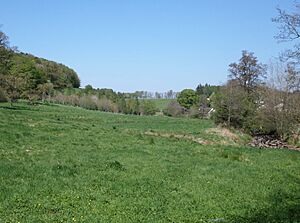Wilhelmina Alexander facts for kids
Quick facts for kids
Wilhelmina Alexander
|
|
|---|---|
| Born | 1756 Newton House, Elderslie, Scotland
|
| Died | 1843 Glasgow, Scotland
|
| Occupation | Lady of Leisure |
Wilhelmina Alexander (1756–1843) was born in Elderslie, Scotland. She was the fourth daughter of Claud Alexander and Joanna Cuninghame. Wilhelmina became famous because the famous Scottish poet Robert Burns wrote a song about her called 'The Bonnie Lass o'Ballochmyle'.
One day, Robert Burns was walking and thinking about his poems near the River Ayr on the Ballochmyle Estate. He saw Wilhelmina and was inspired to write the song about her. At the time, she didn't want the song to be published. Burns was a bit upset by this. However, Wilhelmina kept the letter and the original song manuscript safe until she died. She never married.
Contents
Life at Ballochmyle House
Wilhelmina lived at Ballochmyle House with her brother, Claud Alexander. Claud bought the Ballochmyle Estate in 1783. The previous owner, Sir John Whiteford, had lost a lot of money in a bank problem. Claud had become rich while working for the East India Company in Bengal.
Before the Alexanders owned Ballochmyle, Robert Burns often walked through the private estate. He was friends with the Whiteford family, who owned it then. In 1785, Burns wrote a poem called The Braes of Ballochmyle about the Whiteford family.
Meeting Robert Burns
Wilhelmina never actually spoke to Robert Burns. But where he first saw her, a special little building called a Fog House was built to remember the moment. This happened one July day. The Fog House had a thatched roof and walls that looked like they were made of heather. It was part of the many walking paths on the estate, near the River Ayr.
The Ballochmyle estate is close to Mauchline and Robert Burns's Mossgiel Farm, where Robert lived for a while. One evening, while walking through the private estate, Burns saw Wilhelmina Alexander. She was the owner's sister and was walking alone. This meeting gave him the idea for his romantic song. Wilhelmina quickly left when she saw him.
Burns later wrote her a letter on November 18, 1786. He included a copy of the song and asked for her permission to print it in his second book of poems, called Poems, Chiefly in the Scottish Dialect. The song didn't name her, but it was clear she was the person it was about.
Burns started his letter by saying that poets are "outre Beings" (meaning unusual people). He suggested that poets are allowed more freedom in what they do than other people.
Wilhelmina was at least 30 years old at the time. She wasn't known for being very beautiful. She thought Robert might be making fun of her. After learning more about him and talking to her brother, she decided not to reply to his letter. Burns even asked a friend, Mrs. Stewart of Stair, to try and convince Wilhelmina, but it didn't work.
What Happened Next
Robert Burns' Feelings
When Burns was in Edinburgh, he told his friend Gavin Hamilton how frustrated he was. He said that two of his songs, including the one about Miss Alexander, were judged by writers. They decided the songs were not good enough for publishing and would hurt his reputation. He felt sad about losing these songs that he had worked hard on.
Years later, Burns wrote in his Glenriddell Manuscript about the event. He said, "Did the lady give you the desired permission? No! She was too fine a lady to notice so plain a compliment." He also wrote about her brothers, saying that while they had money, they might not have been very smart or polite.
At the time he wrote the song, Burns was enjoying his new fame from his first book of poems. Wilhelmina's refusal and what he thought was her rude attitude really hurt his pride and confidence. A local poet, Saunders Tait, made things worse. He was invited to Ballochmyle to sing a song he had written about Mrs. Alexander. Tait became a regular visitor at Ballochmyle and even got a reward for his popular song.
The song about Wilhelmina was finally published in 1802, long after Robert Burns had passed away.
Wilhelmina Alexander's View
Later in her life, the letter from Burns became one of Wilhelmina's most treasured possessions. She took it with her everywhere, even when she moved to Glasgow from Ballochmyle. Her relatives tried to keep the letter at the mansion, but she wouldn't let them. As mentioned, the Ballochmyle Fog House was built to honor the occasion of their meeting. Wilhelmina is buried in her family's burial plot in the Old Inchinnan churchyard in Renfrewshire.
These verses from the song were hung on the walls of the Ballochmyle Fog House. The song is also known as Song on Miss Wilhelmina Alexander.
The Lass o'Ballochmyle
|
|
A writer named Douglas described the fog house as a "rustic grotto" and said these two verses were written on a tablet there.
Another visitor, Cuthbertson, came in the 1940s. He wrote about the winding paths that led to the "heather house." He confirmed it was built where the poet, leaning against a tree, first saw Wilhelmina Alexander. He also mentioned a rarely visited "Poet's Seat," which was a horizontal branch of an oak tree where Burns would sit and think about his poems and songs.
See also
- Jean Armour
- Alison Begbie
- Mary Campbell (Highland Mary)
- Nelly Kilpatrick
- Jessie Lewars
- Mary Morison
- Ann Park
- Anne Rankine
- Isabella Steven
- Alexander Tait (poet)
- Peggy Thompson
- Fog House



